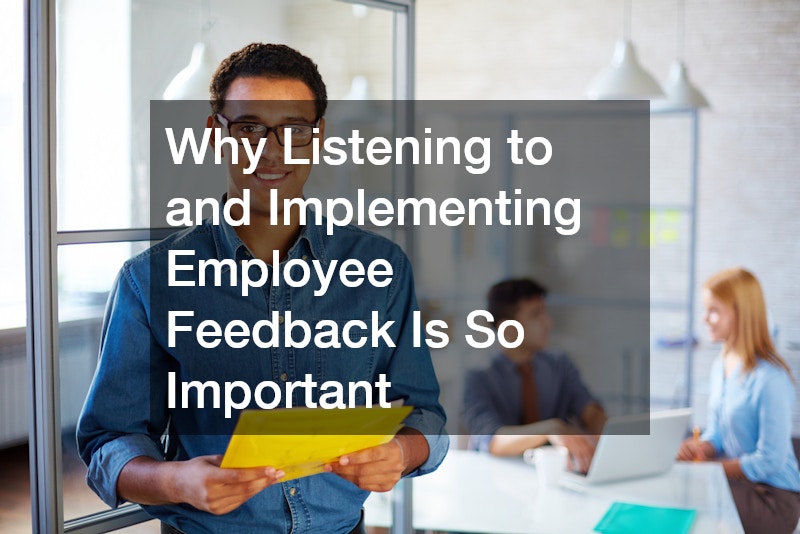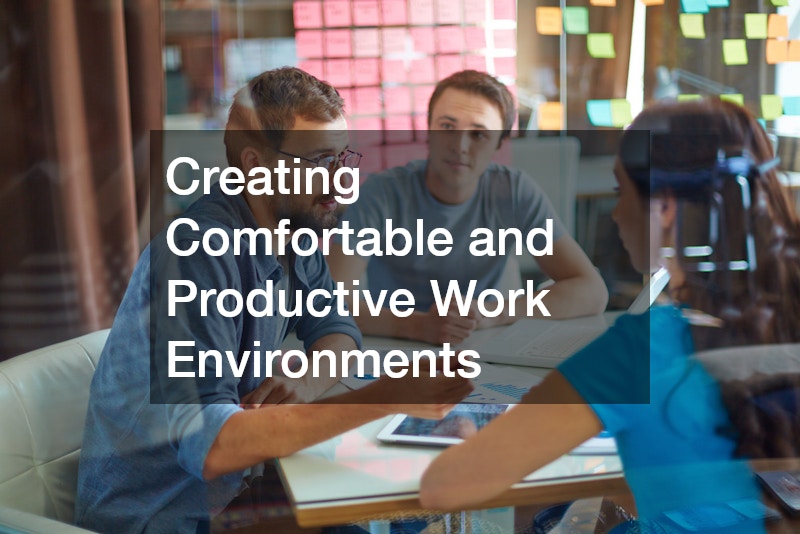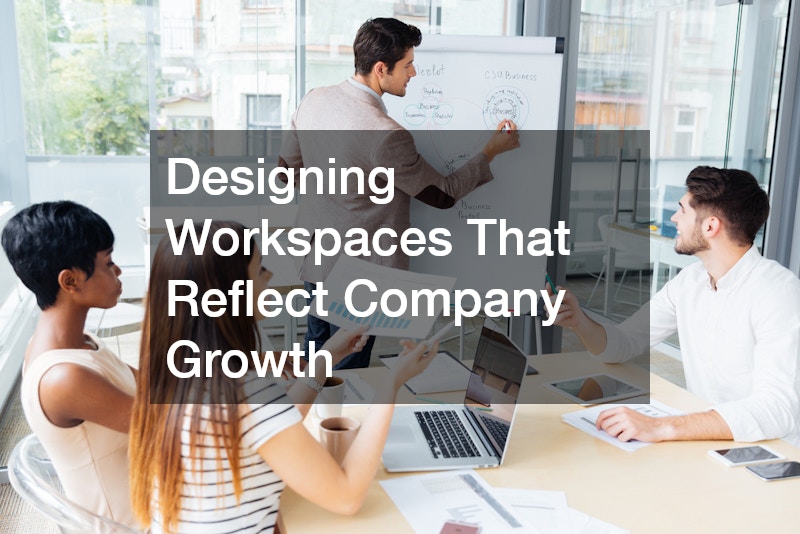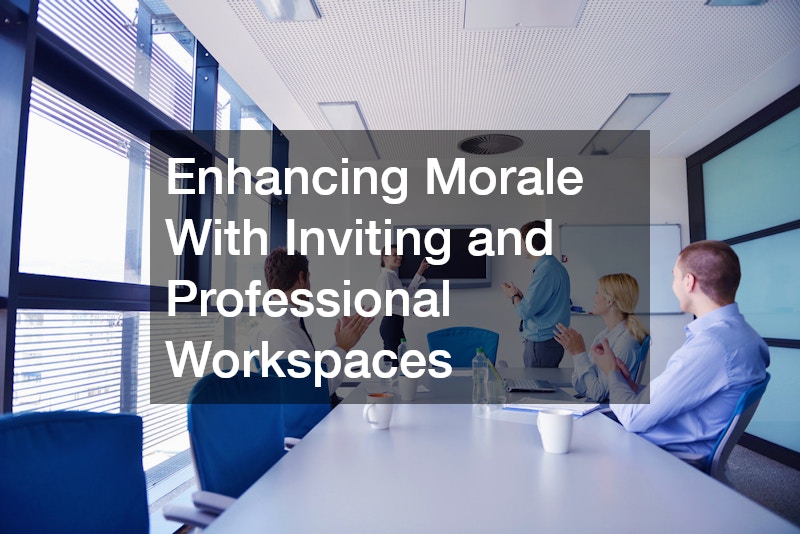Employee feedback is one of the most valuable tools a business can use to grow and improve. When leaders take the time to listen to their team, they gain insights into daily operations, workplace culture, and overall satisfaction. Employees often have a unique perspective on challenges and opportunities within the organization because they experience them firsthand. Encouraging feedback shows that management values transparency and collaboration, which can strengthen trust and loyalty. Implementing suggestions not only boosts morale but also helps a business refine its processes and stay competitive in an evolving market. When employees feel heard and empowered, the entire company benefits from greater innovation, productivity, and engagement.
Building a Healthier and More Supportive Workplace Culture
Listening to employees and taking action on their feedback plays a key role in building a healthy workplace culture. When employees believe their voices matter, they become more invested in their roles and the success of the organization. A culture that prioritizes open communication fosters respect, reduces turnover, and encourages collaboration between departments. It also allows leadership to identify areas where improvements are needed—such as workloads, benefits, or communication gaps—before these issues affect morale. Creating a supportive culture means making sure every team member feels valued and part of the company’s shared goals.
One important way businesses can reinforce this type of positive culture is by offering comprehensive group health insurance to their teams. Health coverage shows employees that the company cares about their well-being beyond the workplace. By gathering feedback on what types of health benefits employees value most, employers can tailor plans that meet diverse needs, such as mental health support, family coverage, or preventive care. These improvements not only enhance employee satisfaction but also contribute to a healthier, more engaged workforce. When feedback-driven decisions directly impact benefits, employees are more likely to stay committed and motivated.
Strengthening Employee Benefits to Encourage Retention
Providing meaningful benefits is one of the most effective ways to retain top talent, and employee feedback is essential in shaping these offerings. When businesses actively ask for input on benefits and compensation, they demonstrate that they care about the financial and personal security of their staff. Employees who feel supported through benefits are more likely to stay long-term and recommend their workplace to others. In competitive industries, thoughtful benefits packages can make a significant difference in attracting and retaining skilled professionals. Gathering regular feedback ensures that benefits evolve with the changing needs of the workforce.
By evaluating employee input, employers can design a health insurance plan that truly aligns with what their teams value most. For some employees, affordability and accessibility are priorities; for others, coverage options like dental, vision, or telemedicine may carry more weight. When businesses use feedback to refine their benefits programs, they create a sense of partnership and trust with their employees. The result is a more loyal workforce that feels appreciated and supported both professionally and personally. Implementing feedback-driven benefits also sends a strong message that the company values long-term relationships rather than short-term results.
Creating Comfortable and Productive Work Environments
A well-designed workspace can have a tremendous impact on employee satisfaction and performance. Employees spend a significant portion of their day at work, and their surroundings directly influence how they feel and perform. Poorly arranged or uncomfortable spaces can contribute to fatigue, reduced focus, and lower morale. On the other hand, work environments that prioritize comfort, accessibility, and aesthetics encourage creativity and collaboration. Gathering and acting on employee feedback about workspace design helps businesses create environments that promote productivity and well-being.
Partnering with local office furniture installers can help businesses implement ergonomic and functional workspace improvements based on employee feedback. Workers often know best which layouts and furniture setups help them stay comfortable and efficient. Installing adjustable desks, supportive seating, and well-organized workstations can make a measurable difference in morale and output. By responding to employee suggestions about their workspace, employers not only improve day-to-day comfort but also demonstrate that they value input on decisions that affect everyone. Investing in better work environments creates a ripple effect—leading to happier employees and better results.
Improving Accessibility and Efficiency in the Workplace
Workplace accessibility and convenience are often overlooked but are essential for maintaining employee satisfaction. Feedback about parking, accessibility routes, and entry systems can reveal hidden challenges that affect daily routines. When employees struggle with practical aspects of getting to and from work or navigating the building, frustration can build up over time. Addressing these logistical concerns shows a genuine commitment to employee comfort and productivity. Efficient workplaces run smoothly because they eliminate unnecessary obstacles that could slow down or inconvenience team members.
Implementing improvements to parking garage systems is one effective way to respond to employee concerns about accessibility. Employees appreciate secure, well-lit, and organized parking areas that make commuting less stressful. Automated entry systems, reserved spaces, or improved layout designs can greatly enhance the daily experience. Companies that act on feedback in this area not only boost morale but also strengthen safety and efficiency. When employees see that leadership values their time and convenience, they feel respected and more motivated to perform their best.
Designing Workspaces That Reflect Company Growth
As businesses grow and evolve, their physical spaces must keep pace with expansion. Employees can offer valuable insights into how work environments should adapt to support new teams, workflows, or technologies. Feedback from staff who use the space every day often highlights inefficiencies that management might overlook. Modern workplaces should reflect the company’s culture and goals, supporting collaboration, creativity, and a sense of pride among team members. A thoughtfully designed workspace signals to employees that the business is committed to progress and innovation.
Upgrading or relocating through strategic commercial real estate decisions allows companies to create spaces that align with both operational needs and employee feedback. Whether it’s expanding into a larger building, adding new meeting areas, or reconfiguring open layouts, these changes can improve functionality and morale. Businesses that consult employees before making major real estate decisions show respect for the people who use the space most. When teams feel heard during these transitions, they adapt more easily and develop a stronger connection to the organization’s vision. A workspace designed with input from employees ultimately enhances both performance and satisfaction.
Supporting Employee Needs Through Reliable Technology
Technology plays a vital role in keeping employees efficient, connected, and engaged. When technical systems are outdated, unreliable, or overly complicated, they can become a major source of frustration that impacts morale and productivity. Regularly gathering feedback from employees about the technology they use allows companies to identify what’s working and what isn’t. Listening to this input helps businesses streamline operations, reduce downtime, and provide the tools employees need to perform at their best. A company that invests in dependable technology shows its commitment to both efficiency and employee satisfaction.
Partnering with a professional it support service allows organizations to address technological concerns quickly and effectively. Employees can share feedback on recurring issues such as slow networks, outdated software, or inadequate data storage solutions, and IT professionals can design solutions to resolve them. Implementing stronger cybersecurity measures, faster communication tools, and cloud-based systems can significantly enhance workflow. When companies take employee feedback seriously and work with experts to improve their technology infrastructure, they empower teams to be more productive and confident in their work. Reliable tech support not only reduces stress but also builds trust and stability across the organization.
Enhancing Morale With Inviting and Professional Workspaces
The visual appearance and atmosphere of a workplace have a direct impact on employee morale. A clean, bright, and visually appealing environment helps employees feel proud of where they work, which can improve overall engagement and productivity. Gathering feedback about workplace aesthetics, such as color schemes, lighting, or decor, helps management understand what inspires their teams. Employees appreciate being part of the process of designing their environment because it gives them a sense of ownership and belonging. A well-maintained, visually inviting space communicates professionalism and care—two values employees naturally respond to.
Utilizing a professional painting service is a simple yet powerful way to incorporate employee feedback into workspace design. Fresh paint can rejuvenate an office, making it feel more open, modern, and inspiring. Whether employees request calming tones for focus areas or vibrant colors for creative spaces, professional painters can bring these ideas to life with precision and quality. The process of involving employees in aesthetic updates strengthens engagement and shows that leadership values their comfort and preferences. Even small upgrades like repainting can lift morale, boost creativity, and reinforce a positive workplace culture.
Promoting Brand Identity and Pride Among Employees
When employees feel proud of their workplace, that pride translates into stronger performance and loyalty. A company’s physical environment and branding play a big role in cultivating that pride. Internal branding elements—such as signage, logos, and company colors—help employees feel connected to the organization’s mission and identity. By gathering feedback on how to enhance visual branding within the workplace, businesses can ensure that the environment reflects not only company values but also employee perspectives. This collaboration fosters unity and reinforces a shared sense of purpose.
Partnering with a custom business sign provider can help businesses integrate brand identity into their workspace in meaningful ways. Employees might suggest areas where signage could improve navigation, add motivation, or enhance the company’s image for visitors. Custom interior and exterior signage can create a consistent, polished look that reinforces professionalism while inspiring employees. Whether it’s a lobby logo wall, motivational quote displays, or directional signs, thoughtful branding helps employees feel part of something bigger. When feedback is used to shape workplace aesthetics, employees see their ideas reflected in their environment, deepening their connection to the company’s identity and success.
Partnering With Experts to Develop Strong Workplace Policies
A company’s policies shape how employees experience their workday—from communication standards to benefits and performance reviews. Listening to employee feedback is critical for ensuring that these policies are fair, effective, and aligned with real workplace needs. When employees are included in policy discussions, they’re more likely to understand, respect, and follow them. Gathering feedback also helps leadership identify areas where current policies may fall short, such as flexibility, diversity initiatives, or work-life balance. By creating policies that reflect employee experiences, companies foster trust, accountability, and long-term engagement.
Collaborating with professional hr companies can help employers gather and implement employee feedback in structured and compliant ways. HR experts can conduct surveys, organize focus groups, and analyze workplace data to identify patterns in employee satisfaction and concerns. They can also help draft or refine policies that promote equity, transparency, and inclusion. Acting on these insights demonstrates that management values employees’ voices in shaping workplace culture. A thoughtful, feedback-driven HR approach leads to stronger retention rates, improved morale, and a reputation as a company that truly listens to its people.
Communicating Effectively to Improve Engagement and Understanding
Effective communication is the foundation of any successful organization. Without clear and open dialogue, even the best feedback can be misunderstood or ignored. Employees want to know that their opinions are not only heard but acted upon. Establishing consistent communication channels allows teams to share their ideas, concerns, and successes freely. When companies create systems that encourage two-way communication, employees feel more empowered to participate in problem-solving and decision-making. This engagement leads to more creative ideas, stronger collaboration, and higher overall satisfaction.
Working with professionals who specialize in technical writing services can help companies improve how they share information internally. Technical writers can translate complex updates, feedback reports, or policy changes into clear, easy-to-understand content that every employee can access. Whether it’s updating handbooks, creating internal newsletters, or drafting reports based on feedback, clear communication ensures that employees stay informed and engaged. When feedback is shared transparently and employees understand how their input is used, they’re more likely to continue contributing in meaningful ways. This creates a cycle of open communication and trust that strengthens the entire organization.
Listening to and implementing employee feedback is more than a management strategy—it’s a long-term investment in the success and stability of a business. When employees feel heard, they’re more motivated, productive, and loyal. Their insights help companies uncover inefficiencies, improve working conditions, and make smarter operational decisions. A culture that embraces feedback encourages innovation and helps businesses adapt to changing workplace trends. By prioritizing communication and collaboration, companies can transform feedback into measurable improvements that benefit both employees and leadership.
The most successful organizations are those that act on what they learn. Whether it’s enhancing employee benefits, upgrading facilities, or refining internal policies, every improvement rooted in feedback builds stronger relationships between employers and their teams. When businesses consistently demonstrate that they value employee input, they create workplaces defined by trust, growth, and shared success. In a competitive market, companies that listen will always lead—because they understand that employee voices are the driving force behind meaningful progress.





